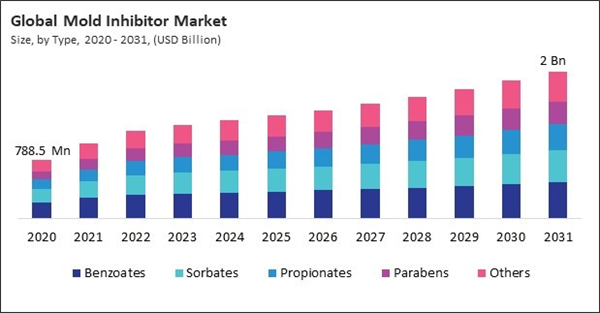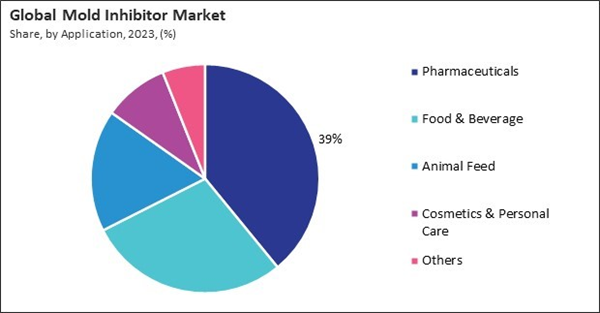Propionates in mold inhibition extend the shelf life of products by inhibiting microbial spoilage. This extended shelf life helps reduce product waste and loss, improves inventory management, and enhances consumer confidence in the quality and freshness of the products over time. Consequently, the propionates segment would acquire nearly 17.5% market share by 2031. Also, propionates are cost-effective inhibitors compared to some alternative preservatives. Their relatively low-cost efficacy and versatility make them economically attractive for manufacturers seeking effective mold control solutions while maintaining product affordability.
Consumers increasingly seek products that offer longevity and durability. Mold growth can compromise various materials' structural integrity and aesthetics, leading to premature deterioration and reduced lifespan. In addition, customers are becoming more conscious of the health risks linked to fungus and mold growth. In conclusion, rising consumer demand for quality products drives the market's growth. Additionally, Biosecurity measures aim to protect the health and welfare of livestock by preventing the introduction and spread of diseases, pathogens, and contaminants within animal production facilities. Moreover, mold contamination in feed ingredients, silage, and animal bedding can result in economic losses for livestock producers due to reduced feed quality, decreased animal performance, and increased veterinary costs. In conclusion, rising biosecurity measures in animal agriculture are propelling the market's growth.
However, developing effective inhibitors often requires extensive research and development (R&D) efforts to identify suitable chemical compounds, optimize formulations, and conduct efficacy testing. In addition, compliance with regulatory requirements and safety standards is essential for these inhibitors to gain market approval and ensure consumer safety. Thus, the constraint of high costs is hampering the market's growth.
Application Outlook
On the basis of application, the market is segmented into animal feed, pharmaceuticals, cosmetics & personal care, food & beverage, and others. In 2023, the food & beverage segment attained 28.5% revenue share in the market. Consumers increasingly seek fresh, minimally processed food and beverage products with extended shelf life. These inhibitors enable manufacturers to meet consumer demand for freshness by preserving product quality and preventing premature spoilage, enhancing consumer satisfaction and loyalty.Type Outlook
Based on type, the market is divided into propionates, sorbates, benzoates, parabens, and others. The sorbates segment attained 22% revenue share in the market in 2023. Sorbates remain effective over various pH levels, including acidic and neutral conditions. This pH stability makes them suitable for acidic food and beverage products where mold growth inhibition is required without affecting product taste or pH balance. Also, sorbates are highly water-soluble compounds, allowing easy incorporation into aqueous solutions, emulsions, and formulations.Regional Outlook
Region-wise, the market is analyzed across North America, Europe, Asia Pacific, and LAMEA. In 2023, the Asia Pacific region witnessed 35% revenue share in the market. The Asia Pacific region is witnessing a population growth and urbanization surge, driving food needs. With higher food production and processing activities comes a greater need for these inhibitors to prevent spoilage and ensure food safety.List of Key Companies Profiled
- DuPont de Nemours, Inc.
- BASF SE
- Eastman Chemical Company
- Kerry Group PLC
- Koninklijke DSM N.V.
- Archer Daniels Midland Company
- Lanxess AG
- Kemin Industries, Inc.
- Corbion N.V.
- Merck KGaA
Market Report Segmentation
By Type
- Benzoates
- Sorbates
- Propionates
- Parabens
- Others
By Application
- Pharmaceuticals
- Food & Beverage
- Animal Feed
- Cosmetics & Personal Care
- Others
By Geography
- North America
- US
- Canada
- Mexico
- Rest of North America
- Europe
- Germany
- UK
- France
- Russia
- Spain
- Italy
- Rest of Europe
- Asia Pacific
- China
- Japan
- India
- South Korea
- Singapore
- Australia
- Rest of Asia Pacific
- LAMEA
- Brazil
- Argentina
- UAE
- Saudi Arabia
- South Africa
- Nigeria
- Rest of LAMEA
Table of Contents
Companies Mentioned
- DuPont de Nemours, Inc.
- BASF SE
- Eastman Chemical Company
- Kerry Group PLC
- Koninklijke DSM N.V.
- Archer Daniels Midland Company
- Lanxess AG
- Kemin Industries, Inc.
- Corbion N.V.
- Merck KGaA










